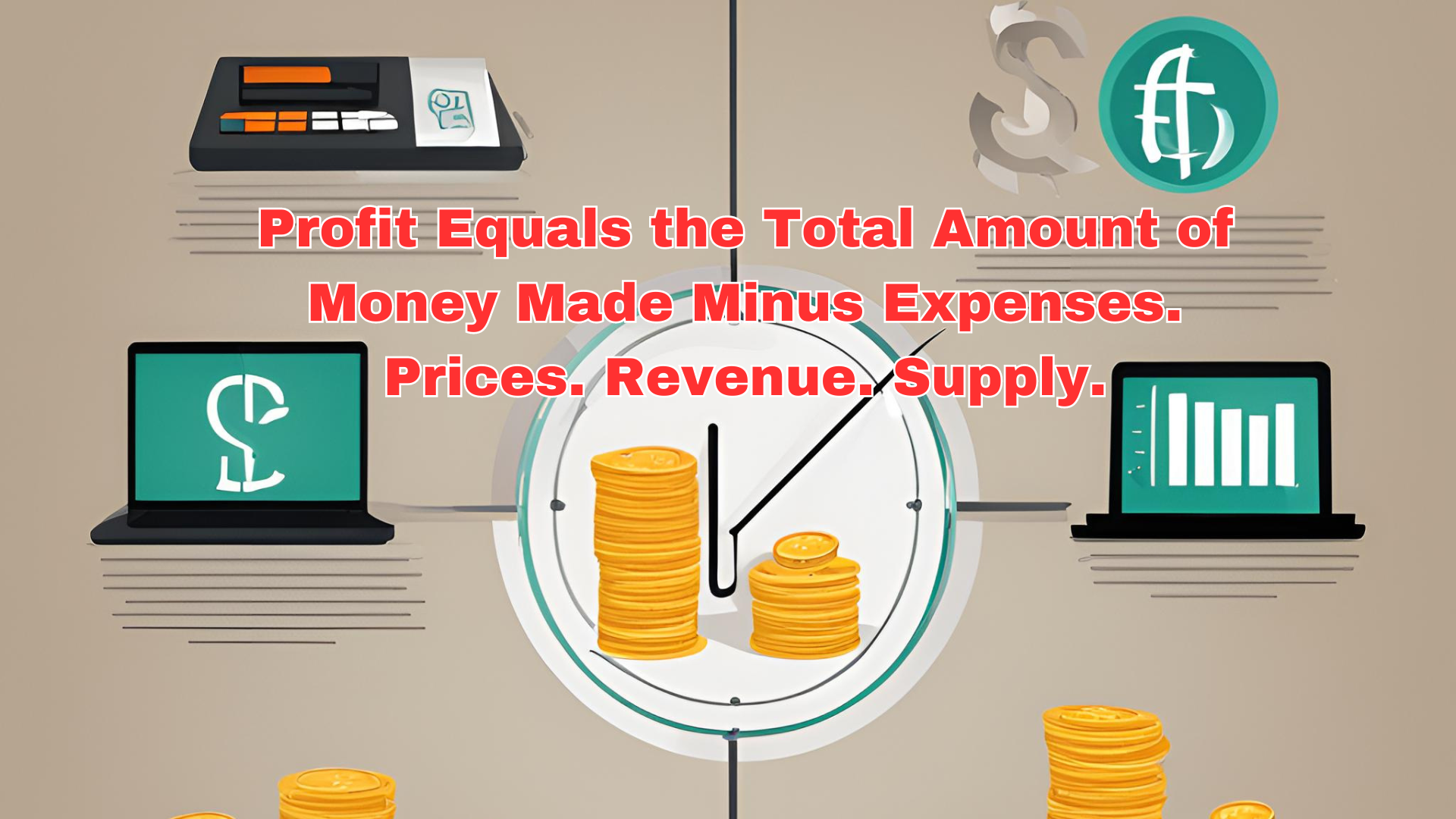Understanding Profit: Calculating Revenue, Expenses, and Supply for Maximum Financial Success
The topic: profit equals the total amount of money made minus expenses. prices. revenue. supply. In the complex world of business and finance, understanding the interplay between key financial metrics is crucial for success. At the heart of this financial ecosystem lies profit, a fundamental indicator of a company’s financial health. Profit represents the difference between total revenue and total expenses, serving as a barometer for a business’s financial performance.
In this comprehensive guide, we’ll delve into the intricate relationships between five essential elements of business finance: profit, revenue, expenses, prices, and supply. By exploring these concepts and their interconnections, you’ll gain valuable insights into how businesses can optimize their operations and maximize profitability.
Defining the Key Terms:
Before we dive deeper into the relationships between these financial elements, let’s clearly define each term:
- Revenue: Revenue, often referred to as the “top line,” is the total amount of money generated from sales of goods or services before any expenses are deducted. It represents the gross income a company earns from its business activities. For example, if a company sells 1,000 units of a product at $50 each, its revenue would be $50,000.
- Expenses: Expenses are the costs incurred in the process of generating revenue. These can include a wide range of outlays, such as:
- Salaries and wages
- Rent and utilities
- Raw materials and inventory
- Marketing and advertising costs
- Equipment and maintenance
- Interest on loans
- Taxes
Expenses are crucial in determining a company’s profitability, as they directly impact the bottom line.
- Profit: Profit, also known as net income or the “bottom line,” is the financial gain realized when revenue exceeds expenses. It’s calculated using the simple formula:
Profit = Total Revenue – Total Expenses
Profit is a key indicator of a company’s financial success and sustainability.
- Prices: Prices are the amounts charged for goods or services. They play a pivotal role in determining revenue and, consequently, profit. Setting the right price is a delicate balance between maximizing revenue and maintaining competitiveness in the market.
- Supply: Supply refers to the quantity of a product or service that the market can offer at various price points. It represents the willingness and ability of producers to provide goods or services to the market. Supply can significantly impact pricing strategies and revenue generation.
The Relationship Between Profit, Revenue, and Expenses:
The interplay between profit, revenue, and expenses forms the foundation of financial analysis in business. Let’s explore how these elements interact:
- The Profit Equation: As mentioned earlier, profit is calculated by subtracting total expenses from total revenue. This simple equation highlights the direct relationship between these three elements. To increase profit, a business must either increase revenue, decrease expenses, or ideally, do both.
- Revenue and Pricing: Revenue is directly influenced by pricing decisions. Higher prices can lead to increased revenue, assuming sales volume remains constant. For instance, if a company raises the price of its product from $50 to $60 and still sells 1,000 units, revenue would increase from $50,000 to $60,000.
However, it’s crucial to note that pricing isn’t always a straightforward decision. Setting prices too high may reduce demand, potentially leading to lower sales volume and, consequently, lower overall revenue. This concept is known as price elasticity of demand.
- The Balancing Act of Expenses: While cutting expenses can improve profit margins, it’s essential to strike a balance. Some expenses, such as marketing or research and development, may be crucial for long-term growth and sustainability. Cutting these expenses too drastically could harm future revenue potential.
- The Profit Margin Perspective: Profit margin, expressed as a percentage, shows how much of each dollar of revenue is kept as profit. It’s calculated as:
Profit Margin = (Profit / Revenue) x 100
This metric helps businesses understand how efficiently they’re converting revenue into profit. A higher profit margin indicates better financial health and operational efficiency.
The Impact of Supply on Profit:
Supply plays a significant role in shaping pricing strategies and, consequently, revenue and profit. Here’s how supply influences these financial metrics:
- Supply and Pricing: The law of supply and demand states that when supply exceeds demand, prices tend to fall. Conversely, when demand outpaces supply, prices typically rise. This dynamic directly impacts revenue and profit margins.
For example, if there’s an oversupply of a particular product in the market, companies may need to lower their prices to remain competitive. This price reduction can lead to lower revenue per unit sold and potentially smaller profit margins.
- Supply Chain Efficiency: Efficient supply chain management can significantly impact expenses. By optimizing inventory levels and reducing waste, businesses can lower their costs and improve profit margins without necessarily changing prices or revenue.
- Supply Flexibility: Companies that can quickly adjust their supply in response to market changes often have a competitive advantage. This flexibility allows them to capitalize on periods of high demand or mitigate losses during market downturns.
- Innovation and Supply: Introducing innovative products or services can create new supply in the market. This innovation can potentially command higher prices, leading to increased revenue and profit margins. However, it often requires significant upfront investment, highlighting the complex relationship between expenses, revenue, and profit.
Conclusion:
Understanding the intricate relationships between profit, revenue, expenses, prices, and supply is crucial for making informed business decisions. These elements form a complex ecosystem where changes in one area can have far-reaching effects on others.
Key takeaways from this exploration include:
- Profit is the result of the interplay between revenue and expenses.
- Pricing decisions directly impact revenue but must consider market demand.
- Effective expense management is crucial for maintaining healthy profit margins.
- Supply dynamics can significantly influence pricing strategies and profitability.
- Flexibility and innovation in supply can provide competitive advantages.
By mastering these concepts and their interconnections, businesses can develop more effective strategies for financial success. Remember, the goal is not just to maximize short-term profit, but to create a sustainable business model that balances all these elements for long-term growth and prosperity.


